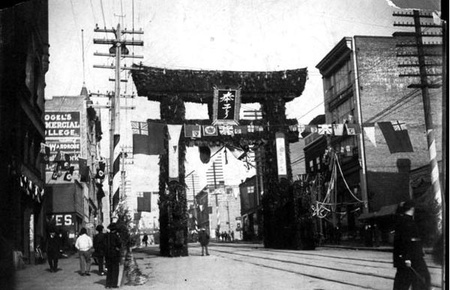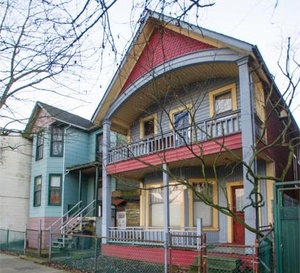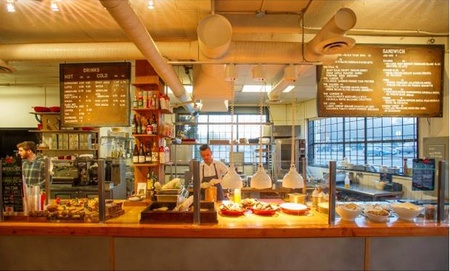U. Morimoto & Co. dry goods rented a storefront at 328 Powell St. for only two years, in 1920 and 1921. But nine decades later, the company name is still written in the tile of the storefront, one of the last remnants of Vancouver’s historic Japantown.

1901 photo of Japanese street arch erected for the visit of the Duke and Duchess of Cornwall and York on Hastings Street west of Cambie. Vancouver Sun photo files. [PNG Merlin Archive]
The 8,000 to 10,000 Japanese-Canadians who lived in Japantown were moved to internment camps in the B.C. interior in 1942, and their properties were sold off a year later. Japanese-Canadians weren’t allowed to return to the west coast until 1949, and Japantown never recovered.
But if you look closely, you can still find traces of the lost neighbourhood. The name “T. Maikawa” is etched into the art deco facade of 365 Powell, where a Japanese-Canadian department store once thrived.
Up the block at 269 Powell, the front entrance to Big Lou’s Butcher Shop reads “Komura,” a grocery store that occupied the building from 1906 to 1941.
The Morimoto, Maikawa, and Komura buildings were all identified as having heritage value in a historical and cultural review done for the city by Birmingham & Wood Architects and Planners in 2008. To date, none has been added to the city’s heritage register.

The last remnants of Alexander Street’s earliest incarnation as a thriving residential street are located at 414 Alexander (left, built in 1889) and 412 Alexander (built in 1898). Photograph by: Arlen Redekop, Vancouver Sun
Neither has 518 Alexander, a small lane house that was built in 1888, when Vancouver was only two years old. Or 414 Alexander, which dates to 1889. Or 441 Powell, which was built in 1890.
The latter building was almost demolished in December, but the demolition was stayed after the building’s age and heritage value became known.
Built as Russ House, a rooming house for itinerant workers during Japantown’s heyday, it was owned by the prominent Uchida family. In recent years, it has been the home of the Ming Sun Benevolent Society, which housed single men from Chinatown’s “Bachelor Society.”
The controversy stirred up over the proposed demolition has turned the spotlight onto Japantown, which has long been something of a no man’s land.
* * * * *
There’s a lot going on.
The area is experiencing a boom in social housing, with three big developments in the works. There is a 10-storey tower with 139 units at 111 Princess Ave. at Alexander Street, and another 10-storey building with 146 units going up at 220 Princess at Powell. The old remand centre (i.e. jail) at 250 Powell is being converted to 95 social housing units, which makes 380 new social housing units in a three-block stretch.
Meanwhile, the area is undergoing something of a commercial renaissance. The Railtown industrial area is humming with activity from the many high-tech, fashion, and design companies who have been attracted to the area for its cheap rents and character buildings.
The Railtown Café at 397 Railway St. has become one of Vancouver’s hottest lunch spots. It is on the ground floor of a lovely art deco building that was built in 1941 for Empire Stevedoring.

The Railtown Cafe at 395 Railway Street is one of a number of thriving new businesses in Vancouver’s historic Japantown. It is located in the art moderne Empire Stevedoring building, which was built in 1941. Photograph by: Arlen Redekop, Vancouver Sun
Nearby the Vancouver Urban Winery has transformed a 1922 steel plant at 55 Dunlevy Ave. into one of Vancouver’s most dramatic spaces, a 65-seat wine bar with six-metre ceilings, banks of wooden barrels, and a functioning construction crane.
The most striking reno is 368 Powell, where Lance Burger of Bon Designworks has brought new life to a century-old structure.
“It’s a complete rebuild,” said Burger. “The building was empty, in semi-collapsed condition. We’ve gutted it and rebuilt it, saved it from extinction.”
It was built for the Japanese Trust Company in 1913 and at some point a giant garage door had been installed in front. Burger brought back the original exterior, then turned the 3,000-sq.-ft. main floor into a big open space for an ultracontemporary office.
“Because of the way it’s built, with the truss system and the ribs for the concrete, you (can) have a clear span,” he explains.
“There’s no interior walls that hold it up. But having said that they’re extremely expensive to fix and bring up to code. It’s a money pit.”
The building came cheap—Burger paid $250,000 in 2005—but Burger says the renos have been “over three times what we paid to buy.”
He did all the renos without any financial assistance or tax breaks from the city. Japantown has no official heritage designation, such as that enjoyed by Gastown and Chinatown, although city planner Kevin McNaney says that may come with a new community plan that should go to council in mid-March.
* * * * *

Lance Burger, who owns a construction company called Bon Designworks with his building at 368 Powell in historic Japantown in Vancouver, BC, January 20, 2014. Photograph by: Arlen Redekop, Vancouver Sun
Burger likes the character of the small heritage buildings in the area, but fears they will get caught between the twin forces of condo development and social housing.
“This area is at a critical turning point, and the current (city) policy will wipe this off the map, because it will be financially unviable to do what we’re doing here,” he said.
“It will be financially viable to push over 200 to 300 linear feet on a block and raise up a beige condo. I’m not saying that’s the end of the world, but it kills the small, independent creative working class, which are in this neighbourhood, flying under the radar. Typically illegally, because they can’t get the proper zoning to do what they’re trying to do.
“We have policy that doesn’t fit the existing condition, and policy which is going to concentrate the social (problems) in this area.”
A new Downtown Eastside Area Plan calls for 3,350 more social housing units in the area in the next 30 years. Some would be built in Chinatown, Gastown, and Strathcona, but most would likely go on Hastings Street or Japantown.
Burger doesn’t think importing more poverty into one of Vancouver’s poorest neighbourhoods is a good idea.
“It’s an undisclosed political agenda to cordon off an area of the city and call it a ghetto,” he says.
“They don’t want to tell you that politically, but that’s what they’re doing here. There’s no other reason to concentrate poverty, the social service agencies, the drug issues, all within this area.
“It’s like putting an alcoholic in a bar and telling him that it’s gonna get better. It doesn’t work.”
The city’s McNaney, on the other hand, thinks the new Downtown Eastside plan will make Japantown a “mixed income community.”
“We see it changing slowly over time,” he said. “It’s primarily a rental housing district right now, whether it’s social housing or market rental, and the plan really sees it remaining a rental housing area. There will be some continued home ownership, of course. (But) we’re adding social mix to that area, in particular we’re adding market rental, as an appropriate mix for that part of town.”
*This article was originally published in the Vancouver Sun on February 8, 2014.
© 2014 John Mackie



